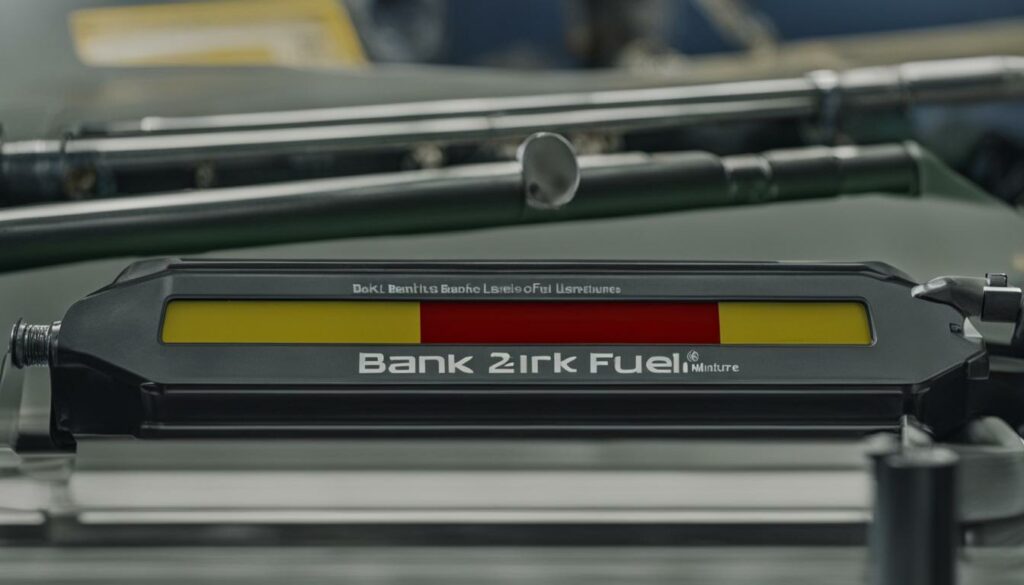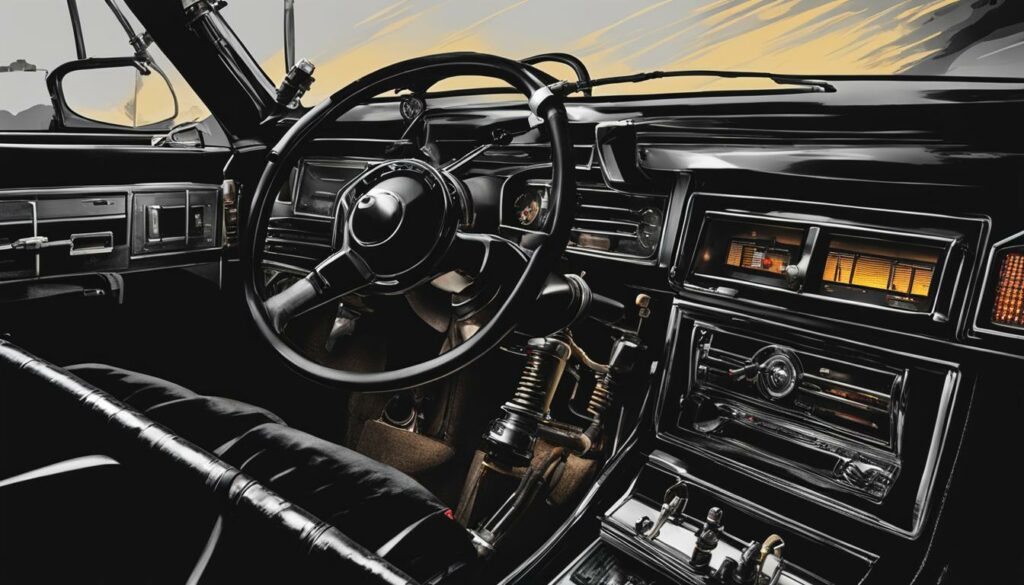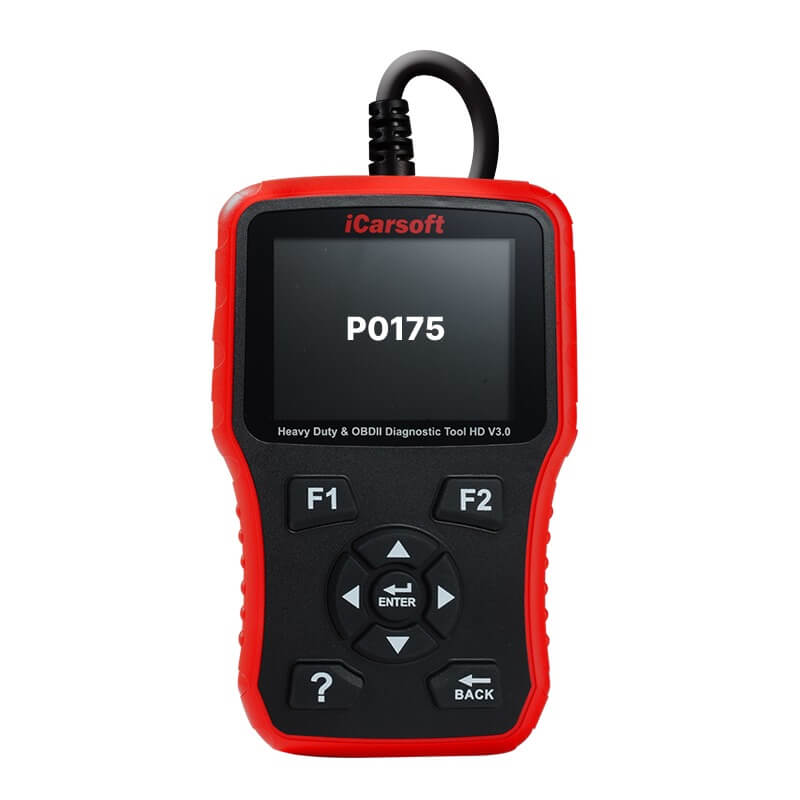P0175 – Fuel Trim System Rich (Bank 2)
POSTED IN pcodes
Welcome to our informative guide on the P0175 code and its implications for your vehicle’s fuel trim system. If you’ve encountered this error, it means that the Engine Control Module (ECM) has detected a rich air fuel mixture on Bank 2. This indicates that there is too much fuel and not enough oxygen in the combustion process, resulting in a lean fuel mixture. It’s important to address this issue promptly to prevent further engine damage and ensure optimal vehicle performance.
Key Takeaways:
- P0175 code indicates a rich air fuel mixture on Bank 2.
- Symptoms include increased fuel consumption, soot from the exhaust, strong odors, and Check Engine Light illumination.
- Possible causes include clogged fuel injectors, faulty oxygen sensors, and fuel delivery problems.
- Proper diagnosis involves checking fuel pressure, inspecting injectors and oxygen sensors, and addressing potential vacuum leaks.
- Consult a professional mechanic for accurate diagnosis and repair.
Causes of a Fuel Trim System Rich (Bank 2)
A fuel trim system rich on Bank 2 can be caused by various issues within the fuel system. Identifying the specific problem requires a thorough fuel system diagnosis. Some common causes of a fuel trim system rich on Bank 2 include:
- Clogged, stuck, or leaking fuel injector
- Faulty fuel regulator
- Dirty or faulty mass air flow sensor
- Faulty coolant temperature sensor
- Faulty thermostat
- Dirty or faulty oxygen sensors
- Vacuum leak
- Fuel delivery problems
- Incorrect fuel pressure
These issues can disrupt the proper air fuel ratio, leading to an excessive amount of fuel and a decreased amount of oxygen in the combustion process. This imbalance can result in fuel consumption and potential engine damage. It is crucial to address the specific cause of the rich fuel trim system in order to ensure optimal vehicle performance and fuel efficiency.

For a visual representation of the causes of a fuel trim system rich on Bank 2, refer to the table below:
Buy tested tuning file for Adblue / EGR / DPF / Adblue off now!
| Cause | Description |
|---|---|
| Clogged, stuck, or leaking fuel injector | A fuel injector that is obstructed, malfunctioning, or leaking can disrupt the proper fuel delivery, leading to an excessive fuel mixture. |
| Faulty fuel regulator | A faulty fuel regulator can result in an inaccurate fuel pressure, causing the fuel mixture to lean towards the rich side. |
| Dirty or faulty mass air flow sensor | A dirty or faulty mass air flow sensor can provide inaccurate readings, leading to an incorrect fuel mixture and a rich condition. |
| Faulty coolant temperature sensor | A faulty coolant temperature sensor can provide incorrect temperature data to the engine control unit (ECU), resulting in a rich fuel trim. |
| Faulty thermostat | A faulty thermostat can cause the engine to run colder than normal, leading to an increased fuel mixture and a rich condition. |
| Dirty or faulty oxygen sensors | Oxygen sensors that are dirty or malfunctioning can provide inaccurate measurements of the exhaust gases, leading to a rich fuel trim. |
| Vacuum leak | A vacuum leak in the intake manifold or associated vacuum lines can introduce additional unmetered air, resulting in a rich fuel mixture. |
| Fuel delivery problems | Issues with the fuel pump, fuel lines, or fuel filter can disrupt the proper fuel delivery, causing a rich fuel trim. |
| Incorrect fuel pressure | If the fuel pressure is too high, it can cause an excessive fuel flow and result in a rich fuel trim. |
Understanding the causes of a fuel trim system rich on Bank 2 is instrumental in troubleshooting and resolving the problem. By addressing the specific issue, you can restore the proper air fuel mixture, improve fuel efficiency, and protect the engine from potential damage.
Symptoms of a Fuel Trim System Rich (Bank 2)
When experiencing a fuel trim system rich on Bank 2, there are several common symptoms to be aware of. Recognizing these symptoms can help you identify and address the issue in a timely manner, preventing further damage to your vehicle.
- Increased fuel consumption: One of the primary indicators of a rich fuel trim system is a noticeable increase in fuel consumption. If you find that you are filling up your gas tank more frequently than usual, it may be a sign of an imbalance in the air fuel mixture.
- Soot or black residue: Another telltale sign of a rich fuel trim system is the presence of soot or black residue coming from the exhaust. This is caused by incomplete combustion due to an excess of fuel and a shortage of oxygen.
- Strong exhaust odors: If you notice strong or unusual odors coming from your vehicle’s exhaust, it could be another indication of a rich fuel trim system. The excess fuel can produce a distinct and pungent smell.
- Check Engine Light illumination: The illumination of the Check Engine Light is a common symptom of various engine issues, including a rich fuel trim system. When the ECM detects an imbalance in the air fuel mixture, it triggers the Check Engine Light to alert you of a problem.
It is important not to ignore these symptoms as a fuel trim system rich on Bank 2 can lead to reduced fuel efficiency, engine damage, and increased emissions. Promptly addressing these issues can prevent further complications and ensure optimal vehicle performance.

If you are experiencing any of these symptoms, it is recommended to consult a professional mechanic for a thorough diagnosis and repair. They will be able to pinpoint the underlying cause of the rich fuel trim system and perform the necessary troubleshooting steps to rectify the issue.
Diagnosing and Repairing a Fuel Trim System Rich (Bank 2)
Proper diagnosis is essential when dealing with a fuel trim system rich on Bank 2. By following these steps, you can identify the specific cause of the issue and perform targeted repairs to resolve it.
1. Check Fuel Pressure
Start by checking the fuel pressure to ensure it falls within the manufacturer’s specified range. If the pressure is too high, it could indicate a faulty fuel pressure regulator. If the pressure is too low, it may point to a fuel delivery problem.
2. Inspect Fuel Injectors
Inspect the fuel injectors for any signs of clogging, restrictions, or leakage. Clean or replace any injectors that are found to be faulty. Clear injectors will help achieve the proper air-fuel mixture and prevent a rich condition.
3. Examine Fuel and Vacuum Lines
Thoroughly examine the fuel lines and vacuum lines for any leaks or damage. Leaks can disrupt the fuel delivery and cause a rich condition. Repair or replace any damaged lines to ensure proper functioning.
4. Inspect Oxygen Sensors
Inspect the oxygen sensors for any contamination or malfunctioning. Faulty oxygen sensors can affect the air-fuel ratio and contribute to a rich condition. Replace any sensors that are found to be faulty to restore proper engine performance.
| Causes | Diagnostic Steps and Repairs |
|---|---|
| Clogged, stuck, or leaking fuel injectors | Inspect fuel injectors for restrictions Replace clogged or faulty fuel injectors |
| Faulty fuel pressure regulator | Check fuel pressure Replace faulty fuel pressure regulator |
| Dirty or faulty mass air flow sensor | Clean or replace mass air flow sensor |
| Faulty coolant temperature sensor or thermostat | Replace faulty coolant temperature sensor or thermostat |
| Vacuum leak | Inspect and repair any vacuum leaks |
| Fuel delivery problems | Check fuel lines for leaks or damage Address fuel delivery problems |
| Incorrect fuel pressure | Verify fuel pressure falls within manufacturer’s specified range Correct fuel pressure issues if necessary |
Summary
Diagnosing a fuel trim system rich on Bank 2 involves checking fuel pressure, inspecting fuel injectors, examining fuel and vacuum lines, and inspecting oxygen sensors. By following these steps, you can identify the underlying cause and perform the necessary repairs to restore optimal engine performance and fuel efficiency.
If you’re unsure about diagnosing or repairing the fuel trim system yourself, it is recommended to consult a professional mechanic who has experience in diagnosing and resolving these types of issues. They have the expertise and specialized tools to accurately diagnose the problem and perform the necessary repairs.
Professional Assistance for Fuel Trim System Rich (Bank 2)
While addressing a fuel trim system rich issue on Bank 2 may seem daunting, professional assistance is available to help you navigate through the diagnosis and repair process. If you are unable to access professional assistance or prefer a cost-effective alternative, there is an option to permanently remove the specific P0175 code by uploading your Engine Control Unit (ECU) file to a specialized portal.
By leveraging the expertise of experienced professionals who are well-versed in ECU tuning and programming, you can effectively eliminate the code causing the fuel trim system rich problem. These specialists will meticulously analyze and modify your ECU file to rectify the issue and optimize your vehicle’s overall performance.
Opting for professional assistance ensures that your fuel trim system rich problem is accurately diagnosed and appropriately addressed. You can rely on the knowledge and skills of these experts to provide you with a comprehensive solution that caters to your specific vehicle needs.
Permanently Removing the P0175 Code
To permanently remove the P0175 code, you will need to upload your ECU file to a specialized portal. Here, professionals will carefully examine the file, identifying the code and making the necessary modifications to permanently eliminate it. By eradicating the code from your ECU file, you can effectively address the root cause of the fuel trim system rich issue and restore your vehicle’s performance to its optimal state.
By opting for this solution, you can have peace of mind knowing that your vehicle’s fuel trim system will be in ideal condition, allowing for improved fuel efficiency and performance. However, it is important to note that uploading and modifying an ECU file requires a high level of expertise in ECU tuning and programming. Therefore, it is recommended to seek assistance from professionals who specialize in this field.
Conclusion
In conclusion, addressing a fuel trim system rich on Bank 2 is crucial for maintaining the optimal performance and efficiency of your vehicle. This issue can lead to decreased fuel efficiency, potential engine damage, and increased emissions, which can impact both your wallet and the environment.
By promptly diagnosing and addressing the specific cause of the rich fuel trim system, such as issues with fuel injectors, fuel regulators, mass air flow sensors, coolant temperature sensors, thermostats, oxygen sensors, vacuum leaks, fuel delivery problems, or fuel pressure, you can ensure that your vehicle runs smoothly and efficiently.
If you’re not confident in diagnosing or repairing these issues yourself, it’s advisable to seek professional assistance. Qualified mechanics have the expertise, specialized tools, and experience to accurately diagnose and effectively repair the problem, ensuring long-term performance and reliability.
Alternatively, if you prefer a cost-effective solution, you can explore the option of permanently removing the specific P0175 code by uploading your ECU file to a specialized portal. This solution, best performed by experienced professionals, can effectively eliminate the rich fuel trim system issue and optimize your vehicle’s performance.
FAQ
What does the P0175 code mean?
The P0175 code indicates that the Engine Control Module (ECM) has detected a rich air fuel mixture on Bank 2. This means that there is too much fuel and not enough oxygen in the combustion process.
What are the common causes of a fuel trim system rich on Bank 2?
The common causes include a clogged, stuck, or leaking fuel injector, a faulty fuel regulator, a dirty or faulty mass air flow sensor, a faulty coolant temperature sensor, a faulty thermostat, dirty or faulty oxygen sensors, a vacuum leak, fuel delivery problems, or incorrect fuel pressure.
What are the symptoms of a fuel trim system rich on Bank 2?
The symptoms include increased fuel consumption, soot or black residue from the exhaust, strong exhaust odors, and the illumination of the Check Engine Light.
How can I diagnose and repair a fuel trim system rich on Bank 2?
Diagnosing and repairing the issue may involve checking the fuel pressure, inspecting the fuel injectors for restrictions, examining the fuel lines and vacuum lines for leaks or damage, and inspecting the oxygen sensors.
Should I seek professional assistance for a fuel trim system rich on Bank 2?
It is recommended to consult a professional mechanic for the proper diagnosis and repair of a fuel trim system rich on Bank 2.
Is there an alternative solution to remove the P0175 code?
Yes, there is an option to permanently remove the specific P0175 code by uploading the Engine Control Unit (ECU) file to a specialized portal for modification.


